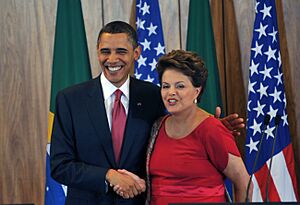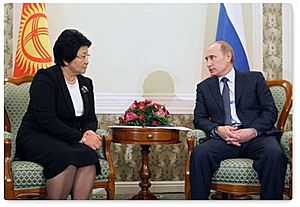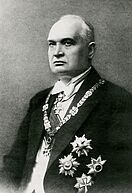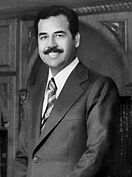President (government title) facts for kids
President is a common title for the head of state in most republics. Depending on the country, a president could be head of government, a ceremonial figurehead, or something between these two extremes.
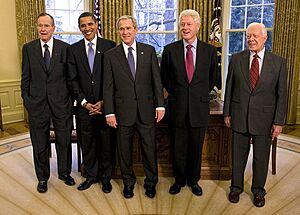
(Left to right: George H. W. Bush, Barack Obama, George W. Bush, Bill Clinton, and Jimmy Carter)

The functions exercised by a president vary according to the form of government. In parliamentary republics, they are usually, but not always, limited to those of the head of state and are thus largely ceremonial. In presidential and selected parliamentary (e.g. Botswana and South Africa) republics the role of the president is more prominent, encompassing the functions of the head of government. In semi-presidential republics, the president has some discretionary powers like over foreign affairs, appointment of the head of government and defence, but they are not themselves head of government. A leader of a one-party state may also hold the position of president for ceremonial purposes or to maintain an official state position.
The title "Mr. President" may apply to a person holding the title of president or presiding over certain other governmental bodies. "Mr. President" has subsequently been used by governments to refer to their heads of state.
Contents
History
The title president is derived from the Latin prae- "before" + sedere "to sit". The word "presidents" is also used in the King James Bible at Daniel 6:2 to translate the Aramaic term סָרְכִ֣ין (sā·rə·ḵîn), a word of likely Persian origin, meaning "officials", "commissioners", "overseers" or "chiefs". As such, it originally designated the officer who presides over or "sits before" a gathering and ensures that debate is conducted according to the rules of order, but today it most commonly refers to an executive official in any social organization. The most common modern usage is as the title of a head of state in a republic.
Description
In the twentieth and twenty-first centuries, the powers of presidencies have varied from country to country. The spectrum of power has included presidents-for-life and hereditary presidencies to ceremonial heads of state.
Presidents in the countries with a democratic or representative form of government are usually elected for a specified period of time and in some cases may be re-elected by the same process by which they are appointed, i.e. in many nations, periodic popular elections. The powers vested in such presidents vary considerably. Some presidencies, such as that of Ireland, are largely ceremonial, whereas other systems vest the president with substantive powers such as the appointment and dismissal of prime ministers or cabinets, the power to declare war, and powers of veto on legislation. In many nations the president is also the commander-in-chief of the nation's armed forces, though this varies significantly around the world.
Presidential systems
In almost all states with a presidential system of government, the president exercises the functions of head of state and head of government, i.e. the president directs the executive branch of government. When a president is not only head of state, but also head of government, this is known in Europe as a President of the Council (from the French Président du Conseil), used 1871–1940 and 1944–1958 in the Third and Fourth French Republics. In the United States the president has always been both Head of State and Head of Government and has always had the title of President.
Presidents in this system are either directly elected by popular vote or indirectly elected by an electoral college or some other democratically elected body.
In the United States, the president is indirectly elected by the Electoral College made up of electors chosen by voters in the presidential election. In most states of the United States, each elector is committed to voting for a specified candidate determined by the popular vote in each state, so that the people, in voting for each elector, are in effect voting for the candidate. However, for various reasons the numbers of electors in favour of each candidate are unlikely to be proportional to the popular vote. Thus, in five close United States elections (1824, 1876, 1888, 2000, and 2016), the candidate with the most popular votes still lost the election.
In Mexico, the president is directly elected for a six-year term by popular vote. The candidate who wins the most votes is elected president even without an absolute majority. The president is allowed to serve only one term.
In Brazil, the president is directly elected for a four-year term by popular vote. A candidate has to have more than 50% of the valid votes. If no candidates achieve a majority of the votes, there is a runoff election between the two candidates with most votes. Again, a candidate needs a majority of the vote to be elected. In Brazil, a president cannot be elected to more than two consecutive terms, but there is no limit on the number of terms a president can serve.
Many South American, Central American, African and some Asian nations follow the presidential model.
Semi-presidential systems
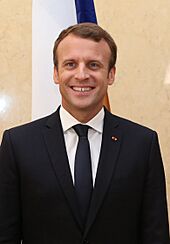
A second system is the semi-presidential system, also known as the French model. In this system, as in the parliamentary system, there are both a president and a prime minister; but unlike the parliamentary system, the president may have significant day-to-day power. For example, in France, when their party controls the majority of seats in the National Assembly, the president can operate closely with the parliament and prime minister, and work towards a common agenda. When the National Assembly is controlled by their opponents, however, the president can find themselves marginalized with the opposition party prime minister exercising most of the power. Though the prime minister remains an appointee of the president, the president must obey the rules of parliament, and select a leader from the house's majority holding party. Thus, sometimes the president and prime minister can be allies, sometimes rivals; the latter situation is known in France as cohabitation. Variants of the French semi-presidential system, developed at the beginning of the Fifth Republic by Charles de Gaulle, are used in France, Portugal, Romania, Sri Lanka and several post-colonial countries which have emulated the French model. In Finland, although the 2000 constitution moved towards a ceremonial presidency, the system is still formally semi-presidential, with the president of Finland retaining e.g. foreign policy and appointment powers.
Parliamentary republics
The parliamentary republic, is a parliamentary system in which the presidency is largely ceremonial with either de facto or no significant executive authority (such as the president of Austria) or de jure no significant executive power (such as the president of Ireland), and the executive powers rests with the prime minister who automatically assumes the post as head of a majority party or coalition, but takes oath of office administered by the president. However, the president is head of the civil service, commander in chief of the armed forces and in some cases can dissolve parliament. Countries using this system include Austria, Armenia, Albania, Bangladesh, Czech Republic, Germany, Greece, Hungary, Iceland, India, Ireland, Israel, Italy, Malta, Pakistan, and Singapore.
A variation of the parliamentary republic is a system with an executive president in which the president is the head of state and the government but unlike a presidential system, is elected by and accountable to a parliament, and referred to as president. Countries using this system include Botswana, Nauru and South Africa.
Dictatorships
In dictatorships, the title of president is frequently taken by self-appointed or military-backed leaders. Such is the case in many states: Idi Amin in Uganda, Mobutu Sese Seko in Zaire, Ferdinand Marcos in the Philippines, Suharto in Indonesia, and Saddam Hussein in Iraq are some examples. Other presidents in authoritarian states have wielded only symbolic or no power such as Craveiro Lopes in Portugal and Joaquín Balaguer under the "Trujillo Era" of the Dominican Republic.
President for Life is a title assumed by some dictators to try to ensure their authority or legitimacy is never questioned. Presidents like Alexandre Pétion, Rafael Carrera, Josip Broz Tito and François Duvalier died in office. Kim Il Sung was named Eternal President of the Republic after his death.
Collective presidency
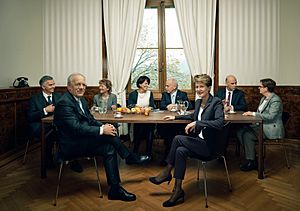
Only a tiny minority of modern republics do not have a single head of state. Some examples of this are:
- Switzerland, where the headship of state is collectively vested in the seven-member Swiss Federal Council, although there is also a president of the Confederation, who is a member of the Federal Council elected by the Federal Assembly (the Swiss parliament) for a year (constitutional convention mandates that the post rotates every New Year's Day).
- The Captains Regent of San Marino elected by the Grand and General Council.
- In the former Soviet Union from 1922 until 1938 there existed an office of collective head of state known as the Central Executive Committee of the Soviet Union that consisted of four and later seven chairmen representing the central executive committees of all union republics from Russia, Belarus, Ukraine, Trans-Caucasusia and from 1925 Uzbekistan, Turkmenistan, Tajikistan. From 1927 until 1989 however, real power was exercised by the General Secretary of the Soviet Communist Party. After 1938, the Presidium of the Supreme Soviet executed powers of a collective head of state, and its chairman was often called "president" in the West, though a singular head of state named "president" was later established in 1990.
- Yugoslavia after the death of Josip Broz Tito, where a presidency consisting of members from each federal unit ruled the country until its breakup.
- Ukraine, in 1918–1920 there existed Directorate composed of seven leaders of parliamentary factions and served as a collective head of state.
- The three-member Presidency of Bosnia and Herzegovina contains a member from each of the country's largest ethnic groups and serves as the collective head of state of Bosnia and Herzegovina
- National Council of Government in Uruguay from 1952 until 1967
- Junta of National Reconstruction in Nicaragua from 1979 until 1985
Presidential symbols
As the country's head of state, in most countries the president is entitled to certain perquisites, and may have a prestigious residence, often a lavish mansion or palace, sometimes more than one (e.g. summer and winter residences, or a country retreat) Customary symbols of office may include an official uniform, decorations, a presidential seal, coat of arms, flag and other visible accessories, as well as military honours such as gun salutes, ruffles and flourishes, and a presidential guard. A common presidential symbol is the presidential sash worn most often by presidents in Latin America and Africa as a symbol of the continuity of the office.
Titles for non-heads of state
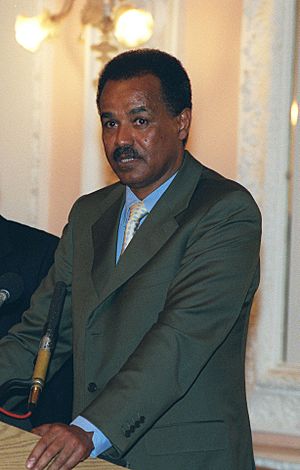
As head of government
Some countries with parliamentary systems use a term meaning/translating as "president" (in some languages indistinguishable from chairman) for the head of parliamentary government, often as President of the Government, President of the Council of Ministers or President of the Executive Council.
However, such an official is explicitly not the president of the country. These officials are called "president" using an older sense of the word, to denote the fact that the official heads the cabinet. A separate head of state generally exists in their country who instead serves as the president or monarch of the country.
Thus, such officials are really premiers, and to avoid confusion are often described simply as 'prime minister' when being mentioned internationally.
There are several examples for this kind of presidency:
- The Prime Minister of Spain is officially referred to as the president of the Government of Spain, and informally known as the "president". Spain is also a kingdom with a reigning king.
- The official title of the Italian Prime Minister is President of the Council of Ministers (Italian Presidente del Consiglio dei Ministri)
- Under the French Third and the Fourth Republics, the "President of the Council" (of ministers – a prime minister) was the head of government, with the president of the Republic a largely symbolic figurehead.
- From 1963 until 1992, the head of government of the Socialist Federal Republic of Yugoslavia was the president of the Federal Executive Council after the 1963 Constitution abolished the office of Prime Minister of Yugoslavia and transferred its functions to the president of the Federal Executive Council. Despite this, foreign media sources continued to refer to individuals holding the office of President of the Federal Executive Council as being the "Prime Minister of Yugoslavia".
- The Prime minister of the Irish Free State from 1922 to 1937 was titled President of the Executive Council of the Irish Free State. At the same time, the Irish Free State was a constitutional monarchy with a reigning monarch, the King of Ireland, as well as a resident Governor-General carrying out many head of state functions.
- Under the constitutional monarchies of Brazil and Portugal, the president of the Council of Ministers (Portuguese Presidente do Conselho de Ministros) was the head of government, with the Monarch being the head of State. Under the Portuguese First and Second Republics, the head of government was the president of the Ministry (Portuguese Presidente do Ministério) and then the president of the Council of Ministers, with the president of the Republic as the head of State.
- The official title of the Croatian prime minister is President of the Government of the Republic of Croatia (Croatian: Predsjednik Vlade Republike Hrvatske).
- The official title of the Polish prime minister is President of the Council of Ministers (Polish Prezes Rady Ministrów).
- In British constitutional practice, the chairman of an Executive Council, acting in such a capacity, is known as a president of the Executive Council. Usually this person is the Governor and it always stays like that.
- Between 1918 and 1934, Estonia had no separate head of state. Both prime ministers (1918–1920) and state elders (1920–1934) often translated as "presidents") were elected by the parliament.
- The head of government of Iran is styled as the "President". The Iranian head of state is the Supreme Leader, to whom the president is subordinate.
President of the United States
Early Presidents
The first president of the United States was George Washington. He was elected in 1789. He was a very important figure in the American Revolution, the war that helped the United States become its own country, independent from Great Britain. He served two terms, from 1789 to 1797. He famously refused a third term, setting a tradition that lasted for many years. He's remembered for his wisdom, his leadership, and his commitment to the new nation. He even helped design the first presidential seal.
After Washington, John Adams became president. He served from 1797 to 1801. He was a strong believer in the importance of education and the rule of law. He was also a skilled diplomat, having served as a representative to Great Britain before becoming president. His presidency was marked by disagreements with political rivals, highlighting the early development of political parties in the United States.
Thomas Jefferson, the third president (1801-1809), is known for the Louisiana Purchase. This was a huge land deal in 1803 where the United States bought a vast territory from France, doubling the size of the country! This expansion westward opened up incredible opportunities for settlement and growth. Jefferson was also a scholar and a writer, authoring the Declaration of Independence.
James Madison, the fourth president (1809-1817), is often called the "Father of the Constitution" because of his crucial role in drafting and promoting the Constitution of the United States. His presidency saw the War of 1812, a conflict with Great Britain that ultimately strengthened American national identity.
James Monroe's presidency (1817-1825) is remembered as the "Era of Good Feelings." This period saw a decrease in political conflict and a sense of national unity. His Monroe Doctrine, a foreign policy statement, declared that the Americas were closed to further colonization by European powers.
The 19th Century
The 19th century saw significant growth and change in the United States. The country expanded westward, leading to conflicts with Native American tribes and debates about slavery. Several presidents during this time grappled with these complex issues.
Andrew Jackson (1829-1837) was a very popular president, but his presidency was also controversial. He expanded voting rights to more white men, but his policies also led to the forced removal of Native American tribes from their ancestral lands, a tragic event known as the Trail of Tears.
Abraham Lincoln (1861-1865) led the country through the Civil War, a devastating conflict fought over the issue of slavery. His Emancipation Proclamation declared the freedom of enslaved people in Confederate-held territory, a pivotal moment in the fight for equality. Lincoln's assassination in 1865 was a national tragedy.
Following the Civil War, the United States underwent Reconstruction, a period of rebuilding and reintegrating the South. Presidents during this era faced the challenges of reuniting a divided nation and establishing civil rights for newly freed African Americans.
The 20th and 21st Centuries
The 20th century saw the United States emerge as a global superpower. Presidents during this time dealt with world wars, the Cold War, and the rise of new technologies.
Theodore Roosevelt (1901-1909) was a strong and energetic president who championed conservation and trust-busting (breaking up large monopolies). Woodrow Wilson (1913-1921) led the country through World War I and proposed the League of Nations, an early attempt at international cooperation. Franklin D. Roosevelt (1933-1945) guided the nation through the Great Depression and World War II, implementing the New Deal, a series of programs designed to alleviate poverty and stimulate the economy.
The Cold War, a period of geopolitical tension between the United States and the Soviet Union, dominated much of the mid-20th century. Presidents like Dwight D. Eisenhower (1953-1961), John F. Kennedy (1961-1963), Lyndon B. Johnson (1963-1969), and Richard Nixon (1969-1974) all dealt with this complex challenge. The space race, the Vietnam War, and the Civil Rights Movement were also defining events of this era.
More recent presidents have faced challenges such as the end of the Cold War, globalization, and terrorism.
See also
 In Spanish: President para niños
In Spanish: President para niños
- Eternal President of the Republic
- Presidential system
- Presidents Day
- Requirements for becoming a president
- Vice president
- First Lady
Head of state
- Governor-General
- Head of state
- List of state leaders
- Monarch
- Supreme Leader (disambiguation)
Other head of government
- Minister-President (a head of government, not of state)
- Prime minister


